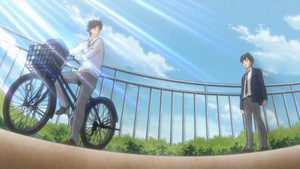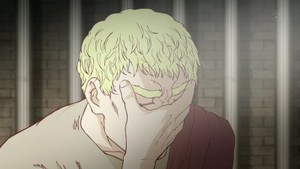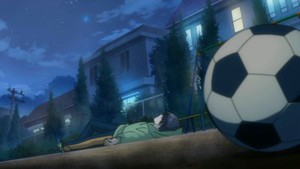The Winter 2012 Anime Preview Guide
Carlo Santos
A veteran of Anime News Network for over 7 years, Carlo (spelled without an "s", thank you very much) is best known for RIGHT TURN ONLY!!, his manga review column. He also writes full-length reviews and convention reports for ANN, sometimes specializing in J-pop music and other weird messes that no one else really understands. His favorite series from the past year include Madoka Magica, Steins;Gate, Hanasaku Iroha, Nichijou/My Ordinary Life, Sket Dance, and Chihayafuru.

Nisemonogatari (Episode 2)
Rating: 4 (of 5)
Review:
In Nisemonogatari Episode 1: Koyomi Araragi talks to girls. In Nisemonogatari Episode 2: Koyomi Araragi talks to girls. The difference? This one gets all the fun characters. After a bumpy start, Episode 2 settles into the rhythm of the witty dialogue that lies at the heart of this series. We begin with an introduction to Koyomi's sisters, Karen and Tsukihi, who apparently are a couple of butt-kicking troublemakers (always the best kind). Then Koyomi goes and finally sees Nadeko Sengoku, the girl he'd been meaning to visit in Episode 1. Things don't really start getting interesting, though, until Koyomi runs into Karen later—her outspoken personality versus Koyomi's world-weariness results in amusing disagreements that only a sibling relationship can provide. Even better is the second half of the episode, where Koyomi hangs out with athletically-inclined Kanbaru Suruga and is immediately flustered by (1) her easygoing attitude towards nudity; (2) her all-consuming pile of BL books.
While this episode lays it on pretty thick with the fanservice (must every female that Koyomi meets try to seduce him?), his self-conscious reactions and the ever-rambling dialogue help to defuse things with constant humor. Not that it's the typical setup-and-punchline type of humor—rather, this one operates on more subtle observations. Koyomi warns us about the dangers of girly-girls who hide a mean streak (Tsukihi), muses on why Suruga is so interested in handsome men being together, and calls out her "nostalgic basketball team memories" when she played all of one game.
Once again, this stream-of-consciousness storytelling is helped along by a distinctive visual style and the subtle but varied music. At its best, the soundtrack even moves along with the rhythm of Koyomi's conversations (listen for the beat when he's on the phone with Suruga). Karen's fancy martial arts moves also prove that there's some serious animation going on here; don't ever expect "talking heads" when Akiyuki Shinbo is going to constantly surprise you with vivid colors, odd angles and sudden scene changes. Indeed, no other series is so artful at transforming the mundane into the bizarre.
Nisemonogatari is available streaming on Crunchyroll.

The Knight in the Area (Episode 2)
Rating: 3 (of 5)
Review:
Episode 2 of The Knight in the Area plays out much like the first, with enough shades of drama (and a tragic twist at the end) to keep things interesting. The episode begins with soccer-loving high schooler Kakeru Aizawa suddenly thrust into a practice match by his older and more talented brother, Suguru. As the game wears on, Kakeru shows flashes of talent, often catching up to the soaring passes kicked to him by Suguru—but despite excellent field position, Kakeru just can't score a goal. After the match, emotions take a dark turn as Suguru starts to mutter about a "lack of heart" and Kakeru gets upset after overhearing what his brother has to say. The second half of the episode is where the story really starts to show its depth: the conflict between Kakeru and Suguru, the unsureness in Kakeru's own heart about what he wants to accomplish, and then a heartbreaking final scene that promises even more dramatic things to come.
Which isn't to say that the series is suddenly getting all dark—the first half of this episode still provides all the requisite soccer excitement, with triumphant music swelling in the background every time Kakeru races downfield and some beautifully angled action shots. But the animation shortcuts are starting to show already, like overuse of freeze-frame scenes (easier than drawing actual motion!) and backgrounds that are often dull and lifeless. The pace of the game also goes through some hiccups, with the action coming to a complete stop every time Suguru gets the ball because someone on the sideline has to explain soccer strategy. If you want to capture the flow of the "beautiful game," you can't afford to take 30-second timeouts to describe every little tactic like a shonen fighting tournament.
Still, the series shows enough promise as a youthful sports story, especially with Kakeru being portrayed as a reluctant protagonist instead of the obligatory hothead or klutz. On the surface, it may look like kids just having fun with soccer—but something serious is definitely building up.
The Knight in the Area is available streaming on Crunchyroll.

Thermae Romae
Rating: 2 (of 5)
Review:
The unusual premise of Thermae Romae has made it one of those series where everyone tells their friends about it simply because it sounds hilarious. "It's about public baths! And how Ancient Rome and Japan have the same thing, only different!" Unfortunately, the anime version of the sleeper-hit manga falls flat in trying to get the joke across, looking more like a cheap cash-in than a committed adaptation.
The first episode introduces us to Lucius, a 2nd-century Roman architect Rome struggling to come up with new design ideas. While relaxing in the public baths, Lucius is mysteriously sucked underwater and emerges in a modern-day Japanese bath. Thus begins a series of predictable culture-shock gags, where Lucius is amazed at the sophistication of Japanese baths: the landscape paintings on the wall, the advertisement posters in the lobby, and the customary bottle of cold milk that comes afterward. So when Lucius re-awakens back in good old Rome, what does he do? Steal all those ideas and apply them to Roman baths, of course.
It's never a good sign when a show is only 15 minutes long, but somehow still manages to run a single joke into the ground. Pretty much all of Lucius's behavior involves being amazed at what Japanese baths have to offer, along with the usual cultural misunderstandings. Apparently the creative staff missed the memo that once you have a funny idea, you have to keep building upon that idea, not rehash it over and over. But what ultimately kills Thermae Romae's appeal is the awful Flash-style animation: most of the "action" in this series involves stiff-looking faces talking to each other or floating across static backgrounds. Any attention to historical detail is lost in the flat, simplified artwork, and the characters might as well be disembodied voices for all the personality they lend to the series (the humor is much more about facts and ideas than it is about people). So let that be a lesson about things that sound hilarious: sometimes it's best to leave them at the "concept" level.
 Inu x Boku SS
Inu x Boku SS
Rating: 2.5 (of 5)
Review:
A short-tempered young heiress, a dashing manservant, an elite-society backdrop, and secret supernatural powers—Inu x Boku SS has it all.
Except, you know, an actual point to the story.
Although Episode 1 contains all of the aforementioned elements, it does little to explain why we should take an interest in what's going on. The heiress is a raven-haired, pint-sized beauty named Ririchiyo, who has just moved into an upper-crust apartment house named Maison de Ayakashi. Soon after she arrives, she is greeted by a silver-haired gentleman named Soushi, a member of the apartment complex's "Secret Service" who offers himself as Ririchiyo's helpful "dog." Much of the episode, then, is taken up by pointless banter where Ririchiyo meets other residents, while Soushi behaves way too enthusiastically. Only in the closing minutes is there any actual conflict: a burglar tries to break in and almost hurts Ririchiyo before Soushi comes bursting in to save her, revealing that all the Ayakashi residents and servants are descended from legendary spirits and folk creatures. Hey, it wouldn't be an anime without special abilities at some point, would it?
Unfortunately, just saying "here's some cool people with spiritual powers living in a nice mansion" isn't enough to make the next episode a must-see. And that's a problem for this show in general: the creative passion is there, but there isn't enough follow-through. The animation, for example, has moments of striking beauty—cascading sakura petals, Soushi's transformation into his true form—but other areas like room interiors and backgrounds look flat and lazy. The character designs are striking, but fall back on overused ideas like the goth-loli tsundere (Gosick and Dantalian and Oreimo all say hi) and multi-colored eyes. At least this episode tries to create a solid foundation by recalling Ririchiyo's childhood and explaining why she's come to the mansion, but looking back is not going to move things forward. This series has the tools to win over gothic-fantasy fans—but does it know how to wield them properly?
Inu x Boku SS is available streaming on Crunchyroll.

Ano Natsu de Matteru
Rating: 3.5 (of 5)
Review:
By virtue of sharing the same creative personnel and story elements, Ano Natsu de Matteru has been called the spiritual successor to Please Teacher!, despite being a stand-alone work. The story centers on high school boy Kaito, an aspiring filmmaker who witnesses a mysterious phenomenon one night while attempting some low-light camerawork. The next day, school continues as usual, but a gorgeous redhead named Ichika has transferred into Kaito's class. Ichika eventually finds her way into Kaito's circle of friends, agreeing to help him with a summer filmmaking project—but their friendship doesn't really start to blossom until, conveniently enough, Kaito invites Ichika to move in with him. (Somehow, she was allowed to register at the school but her local living arrangements fell through; go figure that one out.) It seems that Ichika has some hidden secrets, though, as the strange contents of her luggage appear to be related to the events Kaito witnessed a few nights ago.
On the surface, it's easy to blow this off as another "instant girlfriend and she's an alien" eye-roller, but Episode 1 carries itself with enough grace to stand out from the other shonen romance clones. The laid-back pacing and emphasis on Kaito's friendships at school capture a nostalgic "joy of youth" vibe that is often lost from the crass, screaming, shove-a-girl's-body-parts-in-your-face side of the genre. This episode still sneaks in some inevitable fanservice (yes, Ichika, why don't you freshen up with a shower?), but moments like these are embellishments upon the main story, which is all about the characters, their relationships, and growing up.
Fluid animation is the series' other selling point: the character designs adhere to the usual high-schooler templates, but the way they move—the purposeful gestures, the wide-ranging expressions—add that necessary spark of life. The same goes for the backgrounds, where vivid blues and greens bring out the beauty of Kaito's hometown. The sweet, mostly-acoustic soundtrack is rather quiet, but for a series trying to emphasize the sensitive side of school life, that seems just about right.
Ano Natsu de Matteru is available streaming on Crunchyroll.

Brave 10
Rating: 3.5 (of 5)
Review:
Brave 10 is this season's katana-swinging, shuriken-throwing blockbuster, an action epic high on gloss and maybe a little low on brain cells. Still, after all the simpering schoolyard drivel, we could sure use some fighting spirit. This show brings it in the form of Saizo, a wandering samurai who one day rescues a distressed damsel. The young woman is Isanami, a priestess whose shrine was burned down and is now desperate for help. Saizo reluctantly accompanies Isanami to see feudal lord Sanada Yukimura (that name ring a bell with anyone?), but he refuses to help her in the matter. Thus Saizo and Isanami head back out, but mysterious attackers suddenly stop them in their tracks—and who should show up to aid them in battle but Sanada and his obedient ninja, Sarutobi Sasuke. It seems that the spiritual power lurking in Isanami's headpiece has caught their interest, and a fighter of Saizo's caliber wouldn't hurt, either. So begins a new alliance...
The most striking feature of this series is how visually polished it is, from the picturesque rural backgrounds to architectural flourishes (there's even decorative art on the screen doors) to the elaborate, cosplay-bait character designs. Even better, check out the fight scenes—an early meeting between Saizo and Sarutobi is both graceful and power-packed, and the eventual outburst of Isanami's power features some quality special effects. It's impressive enough that one can forgive the show's clumsier elements, like an all-over-the-place soundtrack that can't seem to decide between a full-blast orchestra, shredding guitars, or jaunty folk music.
However, the first episode is so busy showing off gorgeous artwork and manly swagger that the characters themselves are pretty shallow to start out. Isanami is the worst offender, thinking she can have her way simply by being whiny and helpless (the worst part is, it works), and the other warriors seem to be gathering together simply because they're historically famous and are Pretty Cool Guys. Thankfully, there's enough amped-up fighting action to make the series enjoyable while we wait for a proper storyline to show up.
Brave 10 is available streaming on Crunchyroll.

The Daily Lives of High School Boys
Rating: 1.5 (of 5)
Review:
The only thing worse than a lame, unoriginal plot is a total lack of one. That's the problem with The Daily Lives of High School Boys, which delivers exactly what it says in the title. If you know anything about high school boys, you know that their day-to-day clowning around is hardly the stuff that animated masterpieces are made of.
Episode 1 uses up its one good punchline right at the start, poking fun at this being a Sunrise/Square-Enix production but having nothing to do with Gundam or Final Fantasy. All right, we get it, this is an ordinary slice-of-life show, and that's supposed to be sooo funny. (By the way, nothing kills a joke faster than obnoxiously pointing it out.) The rest of the episode consists of various situations where high-school everyman Tadakuni and his two goofy friends tackle the pressing issues of male adolescence, like how to ask a girl out, how skirts and panties work, what to do when a friend seems to be in a relationship, and coping with idealized romantic situations. That last scene is the only one remotely approaching humor, as it lampoons the oft-sentimentalized "sitting by a riverbank, watching the sunset with a pretty girl" scenario. The other segments, however, are exactly as juvenile and unfunny as one might expect them to be—the kind of screaming boys'-club humor that you're supposed to outgrow once you get past these guys' age.
Not surprisingly, the production values are just as weak as the content itself, with the characters drawn according to bland high-school stereotypes and the color schemes being limited to flat, primary hues. Since most of the action happens in a boy's bedroom, and consists mainly of dialogue, there's about as much visual excitement here as watching turtles race. A forgettable pop-rock soundtrack doesn't do much to enhance these scenes either; the act of "hanging out with the guys" simply does not inspire any creativity. So why it inspired this trash heap of a show may be the ultimate mystery.

LAGRANGE -The Flower of Rin-ne-
Rating: 2.5 (of 5)
Review:
Pretty colors and flashing lights are the only true strong points of Lagrange, which despite its fancy trappings is so derivative that it ought to be named Evangelion by the Seashore. This latest "teenage kid pilots giant robot" iteration places an athletic schoolgirl named Madoka Kyono in the lead role, so at least that's a change from all the boy pilots—but early scenes of Madoka in a school swimsuit, or taking a shower, prove that the target audience remains the same.
After a mind-numbing twelve minutes of Madoka prancing about school, showing off how athletic she is and how many friends she has, the real action eventually kicks in. Lan, a mysterious flightsuit-wearing girl who was rescued by Madoka at the start of the episode, enlists Madoka's help as (1) a friend; (2) a giant robot pilot. And really, when random students come up to ask for your help as a giant robot pilot, do you ever say no?
Thus the series goes from cookie-cutter high school romp to cookie-cutter mecha romp, as Lan flies Madoka to a secret island facility (it's always a secret facility) where a mysterious, futuristic vehicle instantly responds to Madoka's touch (thus proving that she is the "Chosen One"). The higher-ups ask Madoka to get aboard just as a mysterious robot invader touches down nearby (how convenient for them), thus leading to a fist-pumping battle where Madoka's power of being The Chosen One allows her to defeat the enemy without really trying.
As far as story ideas go, this is a spectacularly lazy application of the Destined Mecha Pilot concept. However, it does fare better visually, with a coastal setting that lends itself to sparkling ocean vistas and a slickly animated robot battle that could go in a tourism magazine. Factor in the attractive (if somewhat plain) character designs, and clearly this is meant to be a feast for the eyes. Energetic theme songs also cap the beginning and ending of the episode, but for all its audio-visual indulgence, the whole enterprise still rings hollow on the inside.
LAGRANGE -The Flower of Rin-ne- is available streaming on Viz Anime.

Another
Rating: 4 (of 5)
Review:
The opening scene of Another may be the best first few minutes of any show this season. Over brooding music and stark classroom scenery, a young voice narrates an urban legend: at the local middle school, a girl named Misaki died unexpectedly, and her classmates left her desk untouched out of respect. However, one day a boy claimed that he could still "see" Misaki sitting there, and eventually the entire class started pretending Misaki was still alive. All the way up to graduation. And then ...
And then the loud, melodramatic goth-pop of Ali Project starts up in the theme song, which totally ruins the chilling atmosphere.
Thankfully, the rest of the episode is more in tune with the prologue. The storyline introduces us to Kouichi Sakakibara, a 9th-grader transferring into a rural school. Unfortunately, a sudden illness forces his semester to begin in hospital, but the creepy Stepford students that will soon be Kouichi's classmates are nice enough to pay him a visit. Later on, while wandering the hospital, Kouichi runs into another student—a girl with an eyepatch named Mei Misaki. She mutters some mysterious phrases to him and heads off into the hospital basement, and when Kouichi finally returns to school, he spots her again in class. However, when Kouichi mentions Mei Misaki to anyone, they immediately give him a fearful look, and when he tracks her down to say hello, she ominously tells him that he is marked with the sign of death ...
If good horror-mystery is all about the atmosphere, this one nails it: the quiet yet discordant soundtrack, the suspenseful pacing, even the gray-brown color scheme, which sets a gloomy tone rather than being ugly and boring. Crisp character designs and detailed backgrounds show plenty of visual polish, although the long, silent pauses (for dramatic effect, presumably) suggest that there's still some cost-cutting going on. All the vague, ominous "we'll explain it later" hand-waving is a bit excessive as well. Nonetheless, the dark mood and alluring premise are strong enough to make this series a winner.
Another is available streaming on Crunchyroll.

Recorder and Randsell
Rating: 2 (of 5)
Review: Child predators are no joke, except in Recorder and Randsell, where apparently a grown man greeting a little girl too enthusiastically is high-la-rious. Atsushi is a twentysomething male who (for reasons yet unexplained) is in fifth grade, which means practicing on a recorder for music class and wearing the iconic backpack that signifies elementary school in Japan. On the way to school one day, Atsushi meets a classmate and shows off his new sweater to her by inappropriately opening his trenchcoat—so of course a passer-by gets the wrong idea and Atsushi finds himself arrested.
It's a lowbrow gag to say the least, and if the series insists on continuing to deliver this kind of uncomfortable humor instead of explaining Atsushi's situation, it's going to shed potential viewers pretty quickly. At least the outward presentation is tolerable: the animation (choppy as it may be) goes for a light-toned slice-of-life look, and the tinkly background music is pleasant without being cloying. But even an acceptable level of polish can't distract from the fact that this is a one-joke series based on a rather sleazy "joke."
Recorder and Randsell is available streaming on Crunchyroll.
Poyopoyo
Rating: 2.5 (of 5)
Review: More palatable on the short-attention-span menu is Poyopoyo, which hops on the "cute cats doing cute things" bandwagon with its near-spherical title character. Maru ("round") is a stray cat who is picked up one night by young office lady Moe, and their domestic life together would be clumsily adorable were it not for Moe's brother, who doesn't want a cat in the house.This conflict of interest leads to the inevitable punchline where Maru is more attached to Moe's brother, even though he can't stand the poor thing.
The show's minimalist gag-manga look may not be sophisticated enough for some eyes, but at least the simple shapes, bright colors and crayon lines create a clean, unified style. The visuals also add a spark of energy to the show's paper-thin jokes, like Maru jumping onto a bookshelf and falling off, or imagining that he is Catzilla in his imaginary dream world. Background music is annoyingly repetitive, but really, how annoying can something be if it's barely three minutes long? For a bite-sized dose of cute, this one is a passable choice.
Poyopoyo is available streaming on Crunchyroll.

Nisemonogatari
Rating: 3.5 (of 5)
Review:
There may be no greater barometer of acquired taste this season than Nisemonogatari, the follow-up to the equally idiosyncratic Bakemonogatari. The new show reunites two of anime's most polarizing, love-'em-or-hate-'em creative minds: "drown everyone in dialogue" author NisiOisiN and "look at these quick scene cuts, they make up for stiff animation" director Akiyuki Shinbo. While their combined style can easily be dismissed as obtuse, pseudo-intellectual slop, fans in the right frame of mind will find it to be incredibly well-produced slop.
The story re-introduces us to teenage boy Koyomi Araragi, whose ostensible harem of girls is the biggest bunch of weirdos you're likely to meet. In the opening scene he finds himself imprisoned and taunted by schoolmate Senjougahara, all the while having another one of those captivating-yet-pointless conversations. Later on it's class president and tutor Hanekawa playing verbal volleyball with Araragi, but the ultimate highlight of Episode 1 is when the boy crosses paths elementary-schooler Mayoi Hachikuji. Their conversation comes peppered with sly anime references, pointed linguistic observations (adding the phrase "the courage to" makes any reprehensible act sound okay, and she's right), and musings on the nature of Hachikuji's panties. All right, so maybe the series dips into the lowbrow from time to time.
Where this episode falters is that it basically offers a character recap with no specific story yet. But that doesn't stop it from being fascinating to those who are drawn in by NisiOisiN's style of dialogue; the banter between Araragi and company creates sufficient momentum where the plot falls short. The stylish animation should also hold the attention of viewers, with unusual color schemes and quirky character designs (witness Araragi's amazing morphing cowlick) providing eye candy on a higher artistic level. Odd camera angles and a rapid-fire rhythm, all trademarks of the Shinbo style, also add visual distinctiveness. A sparse, sometimes ambiguous music score is the final touch to the show's cryptic aura—an aura that some will find irresistible, even if others squirm away in confusion.
Nisemonogatari is available streaming on Crunchyroll.

High School DxD
Rating: 1 (of 5)
Review:
There's stuff that's bad because it's lazy and unoriginal, and then there's stuff that's bad because it's downright offensive. High School DxD falls into the latter category, taking the worst of the harem genre and the "schoolkid discovers supernatural powers" formula, then tossing on an extra jiggly layer of fanservice just to make sure anyone with actual standards has been scared off.
The story centers on horny high-schooler Issei, who attends a co-ed academy that was recently converted from an all-girls school (Better odds for the boys! Pathetically contrived plot device!) and dreams of someday interacting with the opposite sex. His wish seems to have come true when, one day, a mysterious schoolgirl named Yuuma asks him out. Unfortunately, Issei's first date takes a disastrous turn when, at the end of the day, Yuuma transforms into a demon and "kills" him. Cue the head-shaking and eye-rolling as everyone realizes this has gone from dumb, derivative shonen romance to dumb, derivative supernatural action.
Luckily, Issei is saved by Rias, the school's foreign-born beauty who is also equipped with supernatural powers. (Guessing by her ridiculous chest size, she's probably equipped with a back brace too.) So now Issei finds himself contracted to Rias, occasionally performing superhuman feats, and involved in a secret intradimensional war ... just like every teenage action-anime protagonist these days, it seems.
With most of the animation effort going into properly rendered breast-jiggle, that leaves little room for any other visual flair. Fight scenes are executed with a predictable repertoire of computer-generated magic circles, mystical glowing auras, and—because this is a "mature" show—unrealistic puddles of blood. The colors are vivid, but not combined in any imaginative way; aside from day-to-day scenes, it's all black, grey, red and occasionally purple because that's supposed to symbolize dark evil forces. Naturally, character designs will be best remembered for the distorted cheesecake proportions among the girls and totally forgettable boys. Meanwhile, the overly dramatic music smacks of trying too hard, a last-ditch effort to make this show seem serious. But all it is, is seriously bad.

The Knight in the Area
Rating: 3 (of 5)
Review:
If The Knight in the Area should be faulted for anything, it's the unapologetic attempt to appeal to mainstream audiences. Episode 1 introduces all the usual shonen-genre stereotypes, heads out in a predictable direction, and hedges its bets on the most popular sport in the world—soccer.
This is the story of Kakeru Aizawa, younger brother of teen phenom Suguru Aizawa. While the elder Aizawa performs extraordinary feats, like scoring against Brazil in an international youth tournament, Kakeru is content to be an equipment manager for the local squad captained by Suguru. The wheels of plot start to turn when a tomboyish-but-now-gorgeous childhood friend, Nana, returns to town (and now you see where the predictability starts to show up). Nana is surprised to see that Kakeru no longer plays actively, considering he was so passionate about soccer as a boy—a passion that only shows itself when Kakeru goes out to practice alone at night. Tensions start to mount when a "mystery player" shows up to challenge Kakeru at one of his practice sessions, and the next day Suguru (who has never been happy with Kakeru's reluctance) forces him to play in a scrimmage match. Perhaps Kakeru's desire is about to be re-ignited ...
Clearly, this isn't the most mind-bending, innovative concept—the characters are built on standard personality tropes, the story events aren't terribly surprising, and the whole rah-rah sports theme is almost embarrassingly optimistic. But there's enough conflict being stirred up to keep things interesting, along with slickly animated soccer scenes (the Japan-Brazil match is the big draw here) and a well-orchestrated soundtrack that manages quite a few other moods besides simply "peppy sporting music." The main character designs are instantly appealing, in a clean-cut friends-next-door kind of way; unfortunately, it looks like the job of animating the supporting characters was handed off to the third-string staff. Still, the overall outlook for this series is positive, with enough polish and substance to hold the interest of shonen fans and sports enthusiasts.
The Knight in the Area is available streaming on Crunchyroll.
 Baby, Please Kill Me
Baby, Please Kill Me
Rating: 2 (of 5)
Review:
The only interesting thing about Baby, Please Kill Me is the unusual title. Everything after that goes rapidly downhill: Episode 1 reveals the show to be yet another hodgepodge of lowbrow gags based on the "wacky schoolgirls messing around" formula. The predictably dopey lead character is Yasuna, a high-schooler (drawn to look about eight years old, for whatever reason) whose best friend Sonya is decidedly un-dopey. It turns out Sonya works a side job as a hired killer, which means she overreacts to just about everything with her elite assassin reflexes. Don't hug Sonya from behind, she'll throw you; put a hand on her shoulder and you can look forward to a broken wrist. Unfortunately these jokes lack proper wit and focus to capitalize on the hired-killer concept—everything just boils down to dumb slapstick overreactions.
The episode's second half is slightly more clever, with self-proclaimed ninja Agiri showing up and displaying her "techniques" in the ancient art. The joke is that most of these techniques are just low-rent substitutes: Agiri "clones" herself by drugging Yasuna so that she sees double, and sells several ninjutsu scrolls that claim to have elemental powers (fire and water) but are really just household gadgets. Having a handful of silly characters like these is hardly a concept to build a series upon, and the lack of actual chemistry between Yasuna, Sonya and Agiri suggests trouble from Day 1.
The cute but bland character designs make the show's 4-panel origins clear to see; they might reproduce easily on a small manga page but look like basic grade-school scribbles on a full-color screen. Even worse are the backgrounds, which try to go for a "sketchy" look with light watercolor and crayon but give off an aura of little or no effort. Of course, subjecting one's self to these visuals would first require getting past the theme song, a raucous mess that is intentionally sung out of tune. There's just too much junk here to enjoy the comedy—if there was any comedy in the first place.
discuss this in the forum (810 posts) |
this article has been modified since it was originally posted; see change history
back to The Winter 2012 Anime Preview Guide
Season Preview Guide homepage / archives